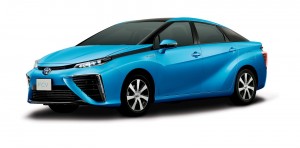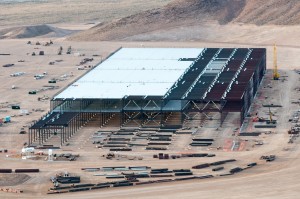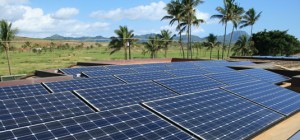 Grid operators on the island of Maui are now routinely “curtailing” wind energy, due to daytime surpluses with so much rooftop solar humming along at the same time that wind peaks. As Utility Dive reports:
Grid operators on the island of Maui are now routinely “curtailing” wind energy, due to daytime surpluses with so much rooftop solar humming along at the same time that wind peaks. As Utility Dive reports:
For the Kaheawa Wind Project, a 51 MW wind installation on island of Maui, curtailment is a fact of daily life. The facility is actually two separate projects — one installed in 2006 and the other in 2012. For KWP II, the latter 21 MW installation, the amount of power not accepted by Maui’s utility can equal amore than a quarter of its annual potential output.
“Last year’s curtailment was on the order of approaching 30% for KWP II,” Steven Rymsha, the plant manager, told Utility Dive during a visit to Maui in March. “That statistic is probably slightly high. It’s in a 25-30% range on a yearly basis.”
30% curtailment is a huge number, and it once again shows why Hawaii is our clean energy “postcard from the future.” Here in California, we will be facing the same problem in the coming years, but we can sell surplus renewables across the west (and import their renewables surplus for our needs).
But Hawaii doesn’t have that option, given its island geography. So why aren’t developers in Hawaii installing energy storage, such as big batteries, to capture surplus energy for later dispatch?
Even as storage prices continue to decline, the MECO grid manager said it remains cheaper for many developers to simply not sell a portion of their power than to invest in a battery and store it.
“To a certain extent, depending on the percentage, curtailment is the cheapest option,” he said. “It’s kind of like if you have a mango tree, you can get all the bottom mangoes sitting under it, and buy a ladder for the middle ones, but you need a bucket truck for the top 10%. It’s probably not worth it.”
I wonder if better rate design or incentives could change this equation significantly enough to encourage more storage deployment. Otherwise, renewable developers will be left needing major price decreases in storage technologies to go that route.
In the meantime, Hawaii should be focusing on the other way to manage this daytime surplus: design rates to encourage energy usage during those peak renewable times and away from non-peak times.
Nevada and Hawaii are two states that have taken different, though both scaled-back, approaches to rooftop solar. But the good news for solar advocates is that both states appear to be making progress, for different reasons.
 First, Hawaii. The Aloha State retrenched from the generous net metering retail rate compensation last year. Instead, state regulators pushed a hybrid option that allows customers to either take a wholesale rate for all power they export or get a retail credit for all the power they use on-site (but not for any exports, which are not credited).
First, Hawaii. The Aloha State retrenched from the generous net metering retail rate compensation last year. Instead, state regulators pushed a hybrid option that allows customers to either take a wholesale rate for all power they export or get a retail credit for all the power they use on-site (but not for any exports, which are not credited).
And in a positive development, the new rates are actually leading to enough customer demand that the state may soon reach its cap on new enrollees. As Utility Dive reports, the cap may be met as soon as next month. What that means is that the economics of the reduced incentives are still working for many customers, and it also gives them an incentive to buy a battery, if they go with the retail rate (in order to maximize their on-site usage).
Granted, Hawaii uniquely has ridiculously high electricity rates and tremendous solar exposure, making it not exactly representative. Still, it shows that the economics of reduced incentives can still work, once the price of the panels comes down (or the price of electricity increases).
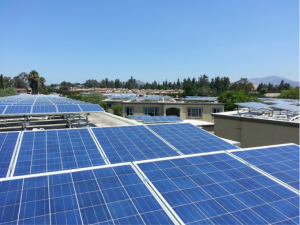 Meanwhile, over in Nevada, the state gutted its solar incentives, even going back on its deal with existing customers, leading to stranded assets and betrayed buyers. But now an electoral push may reverse this decision by voter initiative. The utility is fighting back, per the Las Vegas Review-Journal, but so are solar companies. And there are murmurs that the governor is willing to hash out a deal with the solar companies.
Meanwhile, over in Nevada, the state gutted its solar incentives, even going back on its deal with existing customers, leading to stranded assets and betrayed buyers. But now an electoral push may reverse this decision by voter initiative. The utility is fighting back, per the Las Vegas Review-Journal, but so are solar companies. And there are murmurs that the governor is willing to hash out a deal with the solar companies.
My guess is that Nevada will end up with a compromise, perhaps along the lines of the Hawaii path. And in the long run, we know the current generous net metering incentives won’t last forever. So a future that still encourages deployment and also on-site storage in the form of batteries would be a good one.
In the very long term, rooftop generation may not be the best way forward anyway, particularly given that many people don’t have a rooftop with sun exposure or lack sole access to theirs. So we should be simultaneously encouraging more community solar and microgrids as the best way to decarbonize and localize our electricity systems, leading to greater reliability and cheaper prices in the process.
There’s been a low-grade battle for the future of zero-emission vehicles in California. On one side are the well-known battery electric models, with companies like Tesla capturing the global imagination and state residents buying hundreds of thousands of vehicles to date.
On the other side are hydrogen fuel cell vehicles, capturing the imagination of…well, maybe a hundred buyers and a few state officials.
The problem is that the state is spending millions of dollars to subsidize both technologies, when many experts feel that hydrogen fuel cell vehicles will have very little role in the state’s transportation future.
Now Fred Lambert at Electrek observes that even the fuel-cell automakers are changing their tune:
I think we are witnessing the start of a new (but long overdue) trend this year. The few established automakers still pushing fuel cell hydrogen vehicles appear to be warming up to battery-powered electric vehicles instead. Honda, Toyota and Hyundai, arguably the automakers most stuck on hydrogen, all announced new electric vehicle programs in the past few weeks.
Toyota is working on a plug-in version of the Corolla. Hyundai is bringing its Ioniq electric platform to market by the end of the year and this morning, we reported on the Korea-based automaker developing a next generation battery-powered electric SUV.
Those two automakers are arguably the most entrenched in fuel cell technology with the Toyota Mirai, the Hyundai Tuscon Fuel Cell, and billions spent in investments between the two of them, but the most telling news is that Honda, another fuel cell believer, is planning to launch a battery-powered version of the Clarity, a car it actually developed for its fuel cell program.
Lambert notes the gaping inefficiencies of fuel-cell vehicles compared to battery electrics (which are almost three times more efficient, when accounting for the energy in versus the energy out), plus the greater complexity of the manufacturing/fuel supply process with fuel cells.
The only advantage hydrogen offers over battery electrics is refueling time. But as batteries eventually move to up to the 600-mile range in the coming decades, and as fast-charging technology improves, this benefit will diminish. Meanwhile, battery electrics have the contrary advantage of being able to fuel in your home and anywhere with an outlet, versus the need for the gas station model of hydrogen fueling.
To my mind, the only true benefit of hydrogen is for long-haul trucking (although biodiesel and other biofuels may be just as well-suited), and possibly as a form of energy storage, assuming the hydrogen is made from surplus renewables.
But I’m skeptical that automakers will truly abandon their fuel cell plans so quickly. My guess is it will be another five years or more before they truly get the message from the market.
 Another Aloha Friday from our friends in Hawaii, where record-setting rooftop solar deployment on the island of Molokai is leading to an avoidable and largely policy-made crisis. As the Molokai Dispatch reports:
Another Aloha Friday from our friends in Hawaii, where record-setting rooftop solar deployment on the island of Molokai is leading to an avoidable and largely policy-made crisis. As the Molokai Dispatch reports:
As of last March, 65 solar applications on Molokai were in limbo, following an effective shut-down of Maui Electric to accept additional rooftop solar systems onto the island’s grid. At 51 percent as of last year, Molokai has the highest percentage in Hawaii of rooftop solar compared to the island’s peak electricity demand. Most of the rooftop solar is installed under a program called Net Energy Metering (NEM), which pays customers the retail electric rate for excess energy generated from their panels. Maui Electric asked the PUC to close that program, and their request is still being reviewed.
During a meeting on Molokai in March 2015, Mat McNeff, MECO manager of engineering, told residents because the high volume of solar generation on Molokai could cause fluctuations in electric frequency resulting in potential island-wide power outages, MECO is no longer able to connect new rooftop photovoltaic (PV) systems under the NEM program.
I’m sympathetic to the challenges that this level of solar penetration can cause for grid operators. But there should be a logical and immediate policy response to address the challenges.
First, the utility needs to get permission immediately to revise electricity rates to encourage as much usage as possible during peak solar hours. State regulators should require these time-of-use rates to get island residents to shift as much discretionary usage to mid-day hours and away from night time as possible. I recognize there may be some equity impacts for those unable to shift their usage, but think of the equity impacts right now from holding up all of these solar applications.
Second, state regulators need to develop an immediate incentive program for those with solar applications to also purchase on-site energy storage. Home batteries could help moderate the output from this rooftop energy and provide electricity after the sun goes down. This would greatly help grid operators deal with the frequency fluctuation and avoid having to ramp up other resources quickly around sunset.
While it’s a bit unfair to require this only of new solar customers, it’s a long-term and unavoidable need and better than letting them languish. Plus the incentives could also target existing solar customers.
To be sure, these policy responses aren’t exactly new ideas. They are commonly discussed throughout the U.S. and other places with strong solar policies as long-term needs to deal with increasing solar uptake. But the island of Molokai is experiencing a solar crisis right now, and it’s small enough to implement these ideas quickly and see how they play out.
I hope the utility and state regulators can move quickly to address this problem. The rest of the world will certainly be watching.
For Aloha Friday, I wanted to cite a Utility Dive write-up on a conference in Maui devoted to figuring out how to actually achieve 100% renewables in the islands. The lessons are instructive for all of the world, as Hawaii truly is our postcard from the future for renewables and a clean grid.
 The big topics focused on integrating all these intermittent resources, with better distribution grid visibility for the utility to manage all these “local” storage and renewable assets, as well as better rate design to encourage flexible demand that mirrors intermittent supply.
The big topics focused on integrating all these intermittent resources, with better distribution grid visibility for the utility to manage all these “local” storage and renewable assets, as well as better rate design to encourage flexible demand that mirrors intermittent supply.
But the conference also touched on new business models for the local utilities going forward, as the economics of the grid will change dramatically with 100% renewables.
All in all, another reminder that the island state is worth watching as the rest of the country slowly follows suit.
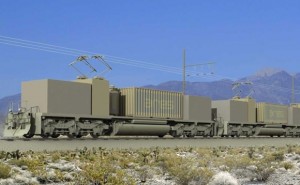 To clean the grid, we’re going to need lots of energy storage to capture surplus renewables and dispatch them when the sun isn’t shining and the wind isn’t blowing. This market for energy storage technologies is growing rapidly, helped by battery innovations spurred in part by electric vehicle deployment.
To clean the grid, we’re going to need lots of energy storage to capture surplus renewables and dispatch them when the sun isn’t shining and the wind isn’t blowing. This market for energy storage technologies is growing rapidly, helped by battery innovations spurred in part by electric vehicle deployment.
But batteries aren’t the only way to store energy, and the recent push is spurring some creative ideas. As an example, gravity could be used in more ways than just pumping water uphill for pumped hydro storage, according to Business Green:
The ARES [Advanced Rail Energy Storage] Nevada project uses the same principles as pumped hydroelectric energy storage projects, but instead of relying on water in a water-stressed region it plans to make use of an inclined rail track and generator locomotive cars that will run along it.
Once operational, the project will encompass 106 acres of public land in Southern Nevada, near Pahrump in Clark and Nye Counties. ARES plans to connect the energy storage system to the power western grid via the facilities of Valley Electric Association, providing grid stabilization services to the region.
It reminds me of a pumped hydro example I read about using the tides: an enclosed container fills up at high tide with seawater, and then the height differential created with low tide allows the water to spill out and spin a turbine. I guess you could call that Tidal Energy Storage.
Either way, it’s encouraging to see some creative and hopefully low-cost projects that could help us solve the energy storage challenge.
Much of our efforts to reduce carbon emissions involves fairly complicated and advanced technologies. Whether it’s solar panels, batteries, flywheels, or fuel cells, these technologies have typically required public support to bring them to scale at a reasonable price, along with significant regulatory or legal reforms to accommodate these new ways of doing old things, from generating power to driving a car.
Yet ironically, here in California we seem to be making the most progress on some of these more technologically advanced areas, and not enough progress in one of the simplest and most cost-effective means of reducing carbon emissions: using less energy in our existing buildings.
Being more energy efficient certainly can involve technological advances, like LED lights instead of incandescent bulbs, lights with sensors that turn off when people leave a room, or more efficient heating or air conditioning units. But it is fundamentally about doing the same with less, and it can often pretty quickly pay off, given the reduction in utility bills that result.
But in California, despite billions spent on energy efficiency efforts, our energy efficiency efforts are barely keeping pace with the increasing demand for electricity. Current utility efficiency programs focus on voluntary, often self-financed measures, with rebates and fixed incentives meant to spur them on. Meanwhile, administrator costs are taking up half of the budgets for many efficiency programs.
Clearly, something needs to change if we are to have any hope of achieving our long-term climate and energy goals in the state. After all, it’s a waste to focus on expensive new renewables and energy storage if we’re not making better progress on the efficient use of the energy we already have.
Given this challenge, the state legislature recently acted to change the nature of our efficiency programs. SB 350 (De Leon, 2015) requires a doubling of efficiency in our buildings by 2030, while AB 802 (Williams, 2015) in part requires utilities to plan for efficiency programs that compensate building owners based on the measured energy saved. These steps will be necessary to change the paradigm and unlock more private investment in energy efficiency retrofits.
To recommend policies to boost this capital market financing for energy retrofits, UC Berkeley and UCLA Law are today releasing a new report “Powering the Savings: How California Can Tap the Energy Efficiency Potential in Existing Commercial Buildings.” The report is the 17th in the two law schools’ Climate Change and Business Research Initiative, generously supported by Bank of America since 2009.
The report describes ways that California could unlock more private investment in energy efficiency retrofits, particularly in commercial buildings. This financing will flow if there’s a predictable, long-term, measured and verified amount of savings that can be directly traced to energy efficiency measures. New software and methodologies can now more accurately perform this task. They establish a building’s energy performance baseline, calibrating for a variety of factors, such as weather, building use, and occupancy changes. That calibrated or “dynamic” baseline can then form the basis for calculating the energy savings that occur due specifically to efficiency improvements.
But the state currently lacks a uniform, state-sanctioned methodology and technology standard, so utilities are reluctant to base efficiency incentives or programs without regulatory approval to use these new methods. The report therefore recommends that energy regulators encourage utilities to develop aggressive projects based on these emerging metering technologies that can ultimately inform a standard measurement process and catalyze “pay-for-performance” energy efficiency financing, with utilities able to procure energy efficiency savings just like they were a traditional generation resource.
To learn more about the report and its recommendations, please join us for a webinar on Monday, April 18th from 10 to 11am. Speakers will include:
- Jeanne Clinton, Special Advisor to Governor Brown for Energy Efficiency, California Public Utilities Commission
- Cynthia Mitchell, energy economist and TURN consultant
- Dennis Quinn, Chief Operating Officer and Co-Founder, Joule Assets. Inc.
You can register via this site.
Hopefully, by tapping into the state’s spirit of innovation, California leaders can show the way to an energy efficiency revolution the way the state helped create a strong market for other clean technologies, like solar panels and energy storage. Because failure on the efficiency front could otherwise nullify so much of our progress in these other areas.
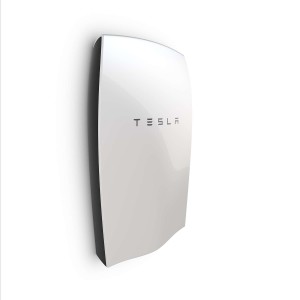 The utility death spiral is a constant topic among energy wonks. The argument is that cheap solar + batteries will lead to declining revenues and grid defection, putting the electric utility on a one-way trip to bankruptcy.
The utility death spiral is a constant topic among energy wonks. The argument is that cheap solar + batteries will lead to declining revenues and grid defection, putting the electric utility on a one-way trip to bankruptcy.
Environmentalists sometimes celebrate this potential, given how many electric utilities have stood in the way of clean technology advances.
But Michael Murray raises the equity question in his inaugural edition of the “Murray Telegraph,” after seeing a presentation from Danna Bailey of Chattanooga’s publicly owned Electric Power Board:
When public commons such as public schools are neglected, then the rich can afford to make their own private schools, and by pulling out their children (and sometimes their money, through vouchers) the public schools grow weaker, encouraging more parents to explore private schools, which begins, perhaps, the educational analog of the utility death spiral.
I found the collectivism of Danna Bailey’s entreaty quite compelling. I want clean energy, but I want the grid to serve the less fortunate, too. The grid provides me with electricity, but in return for my monthly expenditure, I receive much more than electrons: I receive the benefits of an electrified society because my neighbors have power, too. Where is the collectivism of solar plus storage, when rich liberals buy solar panels and PowerWall batteries from Tesla, effectively islanding themselves from the community?
And this future may be coming sooner than many of us realize. As David Roberts summarizes in Vox, solar+storage is getting cheaper and more inevitable:
Grid parity, the moment when solar+storage is as cheap or cheaper than utility power, will arrive on different schedules to different places. But in some places, it’s coming soon — and no place escapes it for more than a few decades.
A few decades may seem like a long time, but it’s much shorter than the life of a power plant. It is well within the time frame in which utilities and regulators need to start planning for it.
Count me among those who celebrate these trends, given the importance of decarbonizing and decentralizing our energy supply. But if it leads to greater inequality and less access to energy for America’s poor, it will be both an economic and moral failure. And an environmental one, to boot.
What’s the answer? Ideally, the technologies become cheap enough that the vast majority of residents can afford to go “off grid.” Then society will have to subsidize access to clean electricity only for the very poor, much like it subsidizes bus transit for those who cannot afford an automobile. And if the technology is truly cheaper, the subsidies shouldn’t be too onerous.
But there may be an awkward transition time in the middle, and it behooves policy makers to figure out how to address it before it’s too late. Otherwise, it will be low-income ratepayers who may be left holding the bag of a deflated electric utility industry.
The future of a clean electricity grid will require more decentralization based on clean technology, like solar and energy storage. Large industrial customers are investing in these technologies and also signing up to moderate their electricity demand in response to larger grid needs (i.e. reducing usage when electricity becomes expensive and dirty to produce). Smaller users like homeowners can become part of a bundled, aggregated group that can produce the same effect as a single large user through automated software and payments that encourage reduced demand at key times.
Under an important federal regulation by the Federal Energy Regulatory Commission (FERC) back in 2011, clean tech companies sell this aggregated change in demand (called “demand response”) to regional grid operators as a package deal. The reduced demand that these companies bundle helps to alleviate strain on the grid, lower economic costs on the wholesale power market, and reduce pollution in the process.
But as I wrote in October, the future of this arrangement was in doubt, with the Supreme Court considering a major challenge to the legality of FERC’s order 745, which enabled this aggregated demand response. The issue is that states control their in-state retail market, while the federal government through FERC can only regulate the wholesale power market across state lines. When FERC allowed clean tech companies to bundle changes in user demand through retail price signals and then sell that aggregated change in demand to regional grid operators in the wholesale power market, opponents argued that FERC was overstepping its bounds into areas under state jurisdiction. Think of it like a commerce clause challenge to FERC authority.
Fortunately, the Supreme Court decided today in a 6-2 vote (Alito recused himself, with Scalia and Thomas dissenting) that FERC’s order was a legitimate regulation under the agency’s wholesale interstate market jurisdiction. As Justice Kagan wrote:
It is a fact of economic life that the wholesale and retail markets in electricity, as in every other known product, are not hermetically sealed from each other. To the contrary, transactions that occur on the wholesale market have natural consequences at the retail level. And so too, of necessity, will FERC’s regulation of those wholesale matters.
The court found that FERC can regulate in areas that directly affect the wholesale power market, as in this demand response arrangement, and that a scheme to provide payments for users to moderate demand and then sell it on the wholesale power market does not constitute a direct setting of in-state retail rates, which would otherwise be under state jurisdiction.
The implications of this decision are critical not just for demand response but for other clean technologies as well. As states look to broaden their clean technology base outside of their boundaries, they’re going to need federal regulations to enable interstate coordination, sometimes grounded at the local level. For example, just as customers can aggregate their retail demand changes to sell to the wholesale power market, they may want to aggregate their on-site energy storage such as using the Tesla PowerWall battery. Or they may want to aggregate power they return to the grid from their plugged-in electric vehicles. Or they may want to share surplus solar power from their roofs across state lines.
The possibilities are myriad and all indispensable to a technology-driven approach to decarbonizing our grid. With the Court’s decision today, this innovation can continue, leading to further economic and environmental benefits for all electricity ratepayers.
The Reno Gazette-Journal checks in for an update on the battery megafactory, and the results are mixed to date:
The Tesla-Panasonic battery gigafactory is falling far short of the economic impact projections on jobs and capital investment used to persuade lawmakers to approve a record-breaking tax incentive package for the project, according to an analysis by the Reno Gazette-Journal.
According to the review of available public documents, the project has generated just a fraction of the jobs, payroll and capital investment projected for the first year in a study commissioned by the Governor’s Office of Economic Development during the 2014 special session.
The numbers also have not kept up with the more refined projections used by Tesla in its application for incentives that will allow the company to operate tax free for a decade and with substantially reduced taxes for a second decade.
Nevada leaders don’t sound worried because the tax benefits go away if certain benchmarks aren’t met. And the factory is already starting to produce home batteries for stationary energy storage.
At this point, it’s probably not a cause for concern, although it may be an indication that construction isn’t where Tesla hoped to be at this point.
Long term, the real value in the Gigafactory for the Reno area is not in construction jobs, but in the higher-paid engineering and other high-skilled jobs that will be located on-site, plus all the supply and service industries that will spring up as a result nearby.
At least Nevada leaders hope that’s the case, given the tax breaks they gave Tesla to lure them there in the first place.

